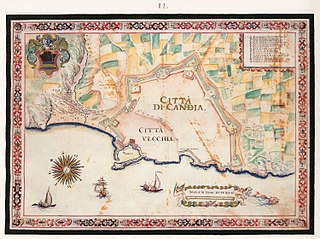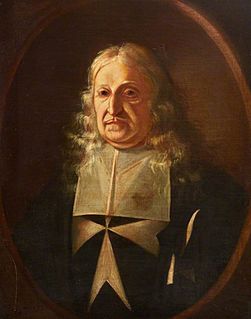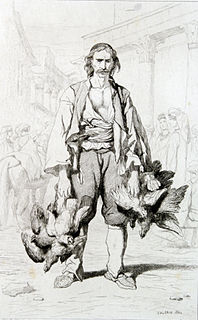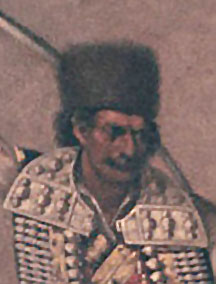 W
WThe Cretan War, also known as the War of Candia or the Fifth Ottoman–Venetian War, was a conflict between the Republic of Venice and her allies against the Ottoman Empire and the Barbary States, because it was largely fought over the island of Crete, Venice's largest and richest overseas possession. The war lasted from 1645 to 1669 and was fought in Crete, especially in the city of Candia, and in numerous naval engagements and raids around the Aegean Sea, with Dalmatia providing a secondary theater of operations.
 W
WFrançois de Vendôme, duc de Beaufort was the son of César, Duke of Vendôme, and Françoise de Lorraine. He was a prominent figure in the Fronde, and later went on to fight in the Mediterranean. He is sometimes called François de Vendôme, though he was born into the House of Bourbon, Vendôme coming from his father's title of Duke of Vendôme.
 W
WFra Gregorio Carafa was a nobleman from the House of Carafa and the 61st Grand Master of the Order of Saint John, from 1680 to his death in 1690.
 W
WStojan Janković Mitrović was the commander of the Morlach troops in the service of the Republic of Venice, from 1669 until his death in 1687. He participated in the Cretan and Great Turkish War, as the supreme commander of the Venetian Morlach troops, of which he is enumerated in Croatian and Serbian epic poetry. He was one of the best-known uskok/hajduk leaders of Dalmatia.
 W
WKöprülü Mehmed Pasha was the founder of the Köprülü political dynasty of the Ottoman Empire, a family of viziers, warriors, and statesmen who dominated the administration of the Ottoman Empire during the last half of the 17th century, an era known as the Köprülü era. He helped rebuild the power of the empire by rooting out corruption and reorganizing the Ottoman army. As he introduced these changes, Köprülü also expanded the borders of the empire, defeating the Cossacks, the Hungarians, and most impressively, the Venetians. Köprülü's effectiveness was matched by his reputation.
 W
WVuk Mandušić was the capo direttore of the Morlach army, one of the most prominent harambaša in the Dalmatian hinterland, that fought the Ottoman Empire during the Cretan War (1645–69). He is one of the heroes renowned in both Serbian and Croatian epic poetry. The Serb poet-prince-bishop Petar II Petrović Njegoš immortalized him in one of his epic poems, Gorski vjenac, also known in English translation as Mountain Wreath.
 W
WMorlachs has been an exonym used for a rural Christian community in Herzegovina, Lika and the Dalmatian Hinterland. The term was initially used for a Vlach pastoralist community in the mountains of Croatia in the second half of the 14th until the early 16th century. Later, when the community straddled the Venetian–Ottoman border in the 17th century, it referred to Slavic-speaking, mainly Eastern Orthodox but also Roman Catholic people. The Vlach i.e. Morlach population of Herzegovina and Dalmatian hinterland from the Venetian and Turkish side were of either Roman Catholic or Christian Orthodox faith. Venetian sources from 17th and 18th century make no distinction between Orthodox and Catholics, they call all Christians as Morlacs. The exonym ceased to be used in an ethnic sense by the end of the 18th century, and came to be viewed as derogatory, but has been renewed as a social or cultural anthropological subject. With the nation-building in the 19th century, the Vlach/Morlach population residing with the Croats and Serbs of the Dalmatian Hinterland espoused either a Serb or Croat ethnic identity, but preserved some common sociocultural outlines.
 W
WFrancesco Morosini was the Doge of Venice from 1688 to 1694, at the height of the Great Turkish War. He was a member of a famous noble Venetian family which produced several Doges and generals. He "dressed always in red from top to toe and never went into action without his cat beside him."
 W
WThe Battle of Perast was a battle for control over Venetian held Perast fought in 1654 between defending forces of Venetian Republic from Perast accompanied by hajduks and attacking forces of Ottoman Empire from Sanjak of Herzegovina. Commander of defending Perast forces was Krsto Vicković while Ottoman forces were led by Mehmed-aga Rizvanagić.
 W
WBajo Pivljanin, born Dragojlo Nikolić, was a Serbian hajduk commander mostly active in the Ottoman territories of Herzegovina and southern Dalmatia. Born in Piva, at the time part of the Ottoman Empire, he was an oxen trader who allegedly left his village after experiencing Ottoman injustice. Mentioned in 1654 as a brigand during the Venetian–Ottoman war, he entered the service of the Republic of Venice in 1656. The hajduks were used to protect Venetian Dalmatia. He remained a low-rank hajduk for the following decade, participating in some notable operations such as the raid on Trebinje. Between 1665 and 1668 he quickly rose through the ranks to the level of harambaša. After the war, which ended unfavourably for the Venetians, the hajduks were moved out of their haven in the Bay of Kotor under Ottoman pressure. Between 1671 and 1684 Pivljanin, along with other hajduks and their families, were refugees in Dalmatia. Upon renewed conflict, he was returned to the Bay of Kotor and placed in charge of defending the frontier; in 1685 he and his band fell in battle against the advancing Ottoman governor of Scutari. Regarded as one of the most distinguished hajduks of his time, he is praised in Serbian epic poetry.
 W
WThe siege of Candia was a military conflict in which Ottoman forces besieged the Venetian-ruled city. Lasting from 1648 to 1669, or a total of 21 years, it is the second longest siege in history after the siege of Ceuta; however, the Ottomans were ultimately victorious despite Candia's resistance.